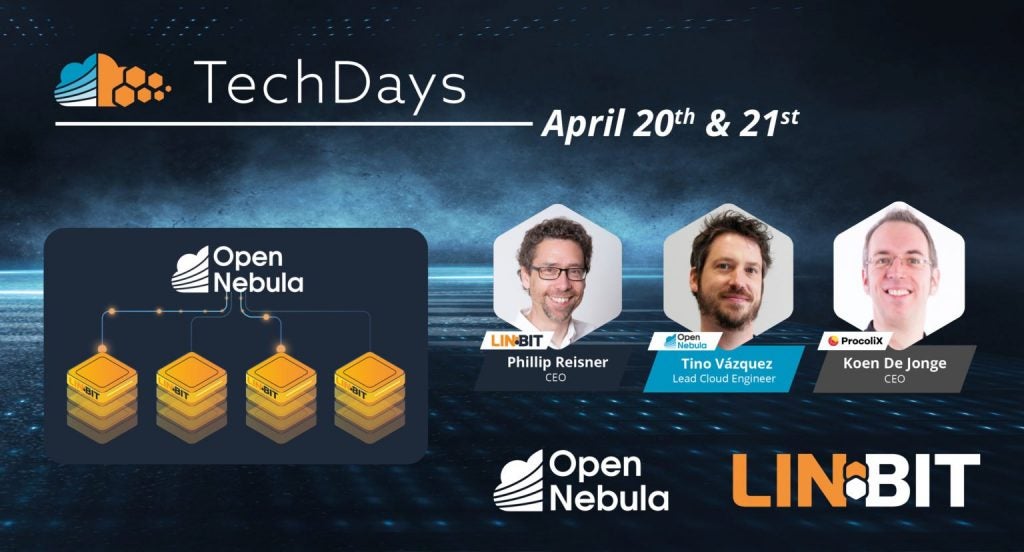OpenShift is flexible in the options available for authentication; here’s how to use htpasswd for authentication.
Read More at Enable Sysadmin
How to create new users in OpenShift with htpasswd and OAuth
OpenStack’s history, community, and 7 of its core projects
A relatively high overview of what OpenStack is, how it came to be, and its most commonly installed services.
Read More at Enable Sysadmin
An introduction to the Quay container registry
Quay is a tool for storing containers, Helm charts, and other container-related content.
Read More at Enable Sysadmin
Open Source Block Storage for OpenNebula Clouds
This post was contributed by LINBIT
The LINBIT OpenNebula TechDays is our mutual attempt to share our combined knowledge with the open source and storage community. We want to give you a thorough understanding of combining LINBIT’s software-defined storage solution with OpenNebula clouds.
OpenNebula is a powerful, but easy-to-use, open source platform to build and manage Enterprise Clouds. OpenNebula provides unified management of IT infrastructure and applications, avoiding vendor lock-in and reducing complexity, resource consumption, and operational costs. In contrast to OpenStack, which understands itself as a collection of independent projects, OpenNebula is an integrated solution that provides all the necessary components to manage a private, hybrid, or edge cloud.
LINBIT SDS is a software-defined storage solution for Linux that delivers highly-available, replicated block-storage volumes with exceptional performance. It matches perfectly with OpenNebula.
Both open source, both born in the Linux software ecosystem. LINBIT SDS is perfectly suited for a hyper-converged deployment with OpenNebula’s hypervisor nodes since it saves a lot on CPU and memory resources when you compare it to Ceph. At the same time, it delivers higher performance (IOPS and throughput) for single volumes and accumulated over all volumes of a cluster.
Find all webinars, case-studies, and discussions listed in the TechDays schedule. It is a free all-virtual event on April 20th and 21st, with direct access to LINBIT and OpenNebula experts.
See you there!
Protected: Apply Here for the Node.js Certification Environment Preview Beta
This content is password protected. To view it please enter your password below:
The post Protected: Apply Here for the Node.js Certification Environment Preview Beta appeared first on Linux Foundation – Training.
Celebrate 30 Years of Linux With Training & Certification Offer
On August 25, 1991, Linus Torvalds posted the now famous Usenet message announcing he was building a free operating system. In the 30 years since, that operating system – Linux – has become the most important open source software project in history, powering all supercomputers, serving as the backbone of the cloud and internet, running a majority of mobile phones and mainframe computers, and even operating on the International Space Station.
After all this time Linux is more important than ever. In fact, the 2020 Open Source Jobs Report from The Linux Foundation and edX found that Linux is the most in demand skill amongst technical hiring managers. This is largely due to rapidly growing adoption of cloud technologies which run on Linux.
To celebrate 30 years of Linux, and to help more individuals become successful, productive members of the Linux community, Linux Foundation Training & Certification is discounting some of our most popular Linux training courses and certification exams through the end of 2021 by 30% with code LINUX30, including:
Certifications:
- Linux Foundation Certified IT Associate (LFCA) – Demonstrates knowledge of fundamental IT concepts including operating systems, software application installation and management, hardware installation, use of the command line and basic programming, basic networking functions, security best practices, and other related topics to validate your capability and preparedness for an entry-level IT position.
- Linux Foundation Certified System Administrator (LFCS) – Demonstrates you have the ability to design, install, configure, and manage a system installation, and understand key concepts such as networking, storage, security, maintenance, logging and monitoring, application lifecycle, troubleshooting, API object primitives and the ability to establish basic use-cases for end users. The discount is valid for the standalone exam or bundled with the associated training course.
- Linux Foundation Certified Engineer (LFCE) – Demonstrates your ability to deploy and configure the Linux operating system at enterprise scale, and shows you possess all the necessary skills to work as a Linux engineer. The discount is valid for the standalone exam or bundled with the associated training course.
eLearning Courses:
- Essentials of Linux System Administration (LFS201) – In this eLearning course, you’ll learn how to administer, configure and upgrade Linux systems running one of the three major Linux distribution families (Red Hat, SUSE, Debian/Ubuntu). You’ll also learn all the tools and concepts you need to efficiently build and manage a production Linux infrastructure. This course also serves as preparation for the LFCS exam.
- Linux Networking and Administration (LFS211) – In this eLearning course, you will learn how to design, deploy and maintain a network running under Linux; how to administer the network services; the skills to create and operate a network in any major Linux distribution; how to securely configure the network interfaces; and how to deploy and configure file, web, email and name servers. This course also serves as preparation for the LFCE exam.
To take advantage of this offer, use code LINUX30 at checkout. Start building your Linux skills and set yourself up for a successful career by enrolling today!
Adding Linux 30th Anniversary to Your Email Signature:
In addition to adding one of the 30th Anniversary graphics to your email signature, please add one of the following lines as well to encourage others to use the graphics and join the celebration:
- Join us in celebrating 30 Years of Linux with these downloadable graphics for your social media, phone background and more!
- Tux Turns 30! Celebrate 30 Years of Linux with these downloadable graphics for your social media, phone background and more!
Restrictions: This promotion is available to anyone who purchases the above-mentioned products with the specified coupon between March 26, 2021, and December 31, 2021, 23:59 PDT. It is not valid for any other combination of e-learning courses or certifications. Promotional price limited to individual purchases or groups of no more than 5. Offer not valid with any other discount combinations.
The post Celebrate 30 Years of Linux With Training & Certification Offer appeared first on Linux Foundation – Training.
Overview of Embedded Linux Development Training
Instructor-led course now includes hands-on labs with a RISC-V based emulated development target
By Behan Webster
We are surrounded by electronic devices that make the modern world work. Almost all of these devices and the systems they run are “Embedded Systems”, which are small purpose-built computers designed to solve specific problems. These computers don’t look like what most people think of as a computer; they don’t have a keyboard, mouse nor monitor. They might even be hidden in normal, everyday objects that you use around the house. The reality is that many of the more powerful embedded systems are running Linux and any “smart devices” around your home or work are almost certainly running embedded Linux.
Embedded systems tend to be smaller, resource-constrained, power-limited, and have a very defined and narrow purpose. Among things, they are your TV, internet modem, wifi access point, smart thermostat, car infotainment system, or home automation system. Everything from smart parking meters to security systems, to the drink dispensers in the cafeteria, and so much of the industrial automation that manufacture and deliver all the things that drive our modern lives, are embedded systems; the vast majority of which run Embedded Linux.
However, all of those things, despite doing different things, work roughly the same way. They tend to have an embedded CPU (often an ARM, MIPS, or increasingly RISC-V), RAM and flash storage, a power budget and a limited number of things that they have to do flawlessly. They all have to power up in a similar way, from boot-loader to configuring the kernel, which brings up the software which makes up the operating system, which in turn runs the application software that makes the device do what it was designed to do.
In the Linux Foundation Training course “Embedded Linux Development“, we cover all the base technologies that are used to build an embedded system and use hands on labs using a RISC-V embedded target to exercise those skills. We start with building an appropriate cross-compiler for the platform, then move on to building, configuring, and extending the boot loader. Building and customizing the Linux kernel, choosing drivers, and making decisions as to what should be included in order to make the system do what it needs to do is next. And then a lot of time is used to discuss how the main operating system should be configured, built, and assembled such that it will meet the needs of your eventual application.
By taking participants through the paces of building up an embedded Linux target from scratch, we ensure they leave with an understanding of the makeup of an embedded system, and how to go down the path of replicating that work in order to build their own device.
Check out Embedded Linux Development, and learn more about all our other embedded Linux training offerings here.
The post Overview of Embedded Linux Development Training appeared first on Linux Foundation – Training.
5 tips to help you prepare for technical certification exams
Five ways you can better prepare yourself for hands-on, technical certification exams.
Read More at Enable Sysadmin
Linus Torvalds on where Rust will fit into Linux (ZDNet)
Rust is popular because it lends itself more easily to writing secure software. Samartha Chandrashekar, an AWS Product Manager, said it “helps ensure thread safety and prevent memory-related errors, such as buffer overflows that can lead to security vulnerabilities.” Many other developers agree with Chandrashekar.
In Linux circles, Alex Gaynor and Geoffrey Thomas at the 2019 Linux Security Summit said that about two-thirds of Linux kernel vulnerabilities come from memory safety issues. Rust, in theory, can completely avoid these by using Rust’s inherently safer application programmer interfaces (API)s.
Exploring the differences between sudo and su commands in Linux
If you’re confused about what su and sudo commands do for you, this brief guide will help you sort them out.
Read More at Enable Sysadmin


